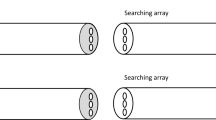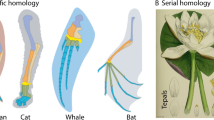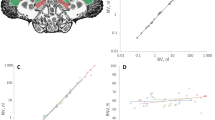Abstract
SYMMETRICAL visual patterns have a salient status in human perception, as evinced by their prevalent occurrence in art1, and also in animal perception, where they may be an indicator of phenotypic and genotypic quality2–4. Symmetry perception has been demonstrated in humans5–8, birds9–11, dolphins12 and apes13. Here we show that bees trained to discriminate bilaterally symmetrical from non-symmetrical patterns learn the task and transfer it appropriately to novel stimuli, thus demonstrating a capacity to detect and generalize symmetry or asymmetry. We conclude that bees, and possibly flower-visiting insects in general, can acquire a generalized preference towards symmetrical or, alternatively, asymmetrical patterns depending on experience, and that symmetry detection is preformed or can be learned as a perceptual category by insects, because it can be extracted as an independent visual pattern feature. Bees show a predisposition for learning and generalizing symmetry because, if trained to it, they choose it more frequently, come closer to and hover longer in front of the novel symmetrical stimuli than the bees trained for asymmetry do for the novel asymmetrical stimuli. Thus, even organisms with comparatively small nervous systems can generalize about symmetry, and favour symmetrical over asymmetrical patterns.
This is a preview of subscription content, access via your institution
Access options
Subscribe to this journal
Receive 51 print issues and online access
$199.00 per year
only $3.90 per issue
Buy this article
- Purchase on Springer Link
- Instant access to full article PDF
Prices may be subject to local taxes which are calculated during checkout
Similar content being viewed by others
References
Caglioti, G. Symmetriebrechung und Wahrnehmung (Vieweg, Braunschweig, 1990).
Møller, A. P. Nature 357, 238–240 (1992).
Møller, A. P. Behavl Ecol. Sociobiol. 32, 371–376 (1993).
Swaddle, J. P. & Cuthill, I. Nature 367, 165–166 (1994).
Corballis, M. C. & Roldán, C. E. J. exp. Psychol. 1, 221–230 (1975).
Pashler, H. J. exp. Psychol. 16, 150–163 (1990).
Barlow, H. B. & Reeves, B. C. Vision Res. 19, 783–793 (1979).
Bornstein, M. H., Ferdinandsen, K. & Gross, C. G. Devl Psychol. 17, 82–86 (1981).
Delius, J. D. & Habers, G. Behavl Biol. 22, 336–342 (1978).
Delius, J. D. & Nowak, B. Psychol. Res. 44, 199–212 (1982).
Menne, M. & Curio, E. Z. Tierpsychol. 47, 299–322 (1978).
von Fersen, L., Manos, C., Goldowsky, B. & Roitblat, H. in Marine Mammal Sensory Systems (ed. Thomas, J. et al.), 753–762 (Plenum, New York, 1992).
Rensch, B. Z. Tierpsychol. 14, 71–99 (1957).
Menzel, R. & Shmida, A. Biol. Rev. 68, 81–120 (1993).
Møller, A. P. & Eriksson, M. J. evol. Biol. 7, 97–113 (1994).
Wehner, R. in Handbook of Sensory Physiology (ed. Autrum, H. J.), Vol. VII/6C, 287–616 (Springer, Berlin, 1981).
van Hateren, J. H., Srinivasan, M. & Wait, P. B. J. comp. Physiol. A167, 649–654 (1990).
Giurfa, M., Backhaus, W. & Menzel, R. Naturwissenschaften 82, 198–201 (1995).
Hertz, M. Z. vergl. Physiol. 8, 693–748 (1929).
Horridge, G. A., Zhang, S. W. & Lehrer, M. Phil. Trans. R. Soc. Lond. B337, 49–57 (1992).
Srinivasan, M. J. Insect Physiol. 40, 183–194 (1994).
Srinivasan, M., Zhang, S. & Witney, K. Phil. Trans. R. Soc. Lond. B343, 199–210 (1994).
Marc̆elja, S. J. opt Soc. Am. 70, 1297–1300 (1980).
Osorio, D. Proc. R. Soc. B263, 105–110 (1996).
Menzel, R. Z. vergl. Physiol. 56, 22–62 (1967).
Giurfa, M., Núñez, J. A., Chittka, L. & Menzel, R. J. comp. Physiol. A177, 247–259 (1995).
Lehrer, M., Horridge, G. A., Zhang, S. W. & Gadagkar, R. Phil. Trans. R. Soc. Lond. B347, 123–137 (1995).
Møller, A. P. Proc. natn. Acad. Sci. U.S.A. 92, 2288–2292 (1995).
Enquist, M. & Arak, A. Nature 372, 169–172 (1994).
O'Carrol, D. Nature 362, 541–543 (1993).
Author information
Authors and Affiliations
Rights and permissions
About this article
Cite this article
Giurfa, M., Eichmann, B. & Menzel, R. Symmetry perception in an insect. Nature 382, 458–461 (1996). https://doi.org/10.1038/382458a0
Received:
Accepted:
Issue Date:
DOI: https://doi.org/10.1038/382458a0
This article is cited by
-
Flower symmetry in Saxifraga revisited
Plant Systematics and Evolution (2023)
-
Navigation and dance communication in honeybees: a cognitive perspective
Journal of Comparative Physiology A (2023)
-
Geometry-based navigation in the dark: layout symmetry facilitates spatial learning in the house cricket, Acheta domesticus, in the absence of visual cues
Animal Cognition (2023)
-
Complex preference relationships between native and non-native angiosperms and foraging insect visitors in a suburban greenspace under field and laboratory conditions
The Science of Nature (2023)
-
Recurrent connections facilitate symmetry perception in deep networks
Scientific Reports (2022)
Comments
By submitting a comment you agree to abide by our Terms and Community Guidelines. If you find something abusive or that does not comply with our terms or guidelines please flag it as inappropriate.



